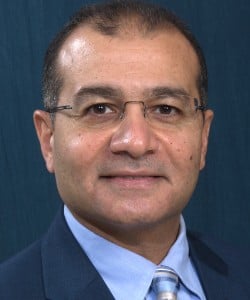Transitional Pain Services: Closing the Gap Between Acute and Chronic Pain
Cite as: Elsharkawy H, Clarke H, Schwenk E. Transitional pain services: closing the gap between acute and chronic pain. ASRA Pain Medicine News 2022;47. https://doi.org/10.52211/asra020123.011
Introduction
The development of chronic postsurgical pain (CPSP) is currently a major concern after surgery. Patients with CPSP use a disproportionate amount of healthcare resources, driving up costs and potentially leading to poor quality of life. Patients suffering from CPSP have limited treatment options and often are overly reliant on opioids.
Our current perioperative pain model is reactive rather than proactive and often focuses on temporary, short-term solutions for problems that may require a more comprehensive approach.
There are many problems with the current fragmented perioperative pain management model of care. During this transition time, neither acute nor chronic pain physicians are typically managing such patients, leaving the primary surgeon to manage pain that does not follow the typical postoperative course. In many cases, the surgeon is not trained to manage this type of pain. In addition, our current perioperative pain model is reactive rather than proactive and often focuses on temporary, short-term solutions for problems that may require a more comprehensive approach. Opioids are often used and sometimes escalated because of the lack of familiarity with other approaches.
Reducing the Development of Chronic Pain
The perioperative period represents a time during which some patients are vulnerable to the potentially lasting effects of poorly controlled pain. While the majority of patients recover from surgery without difficulty and discontinue opioid analgesics after a short course, a notable minority of patients do not follow the typical trajectory and go on to develop chronic postsurgical pain (CPSP). Multiple studies have attempted to identify such patients, and while not every study comes to the same conclusions, some patient characteristics consistently identified include those with anxiety and depression,1, 2 those taking opioids preoperatively,3 those with substance or alcohol abuse history,4 and those who are pain catastrophizers.1 For those patients, routine perioperative analgesia may not be adequate.
Some potential strategies to optimize analgesia perioperatively include using regional anesthesia whenever possible, incorporating multimodal analgesia that minimizes reliance on opioids, and setting expectations preoperatively regarding one’s expected pain level and expected dose and duration of opioids that will be prescribed, if any. It should be noted, however, that several studies, including a multicenter study trial published in Lancet, found that regional anesthesia with total IV anesthesia was not superior in preventing CPSP compared with standard balanced anesthesia.5 Opioid-free anesthesia has been a topic of multiple recent studies but a meta-analysis failed to show clinically meaningful improvements in pain outcomes, and only postoperative nausea and vomiting was reduced to a meaningful degree.6 One challenge with opioid-free anesthesia was illustrated in a study in which patients who received opioid-free anesthesia had better analgesia during hospitalization but, at discharge, were prescribed the same dose of opioids by surgeons as they normally would have been.7
Clearly, impacting long-term outcomes has no simple fix and the myriad of factors that contribute to CPSP make finding solutions very challenging. Effective solutions will likely require buy-in from both anesthesiologists and surgeons, and all parties must have their goals aligned to attempt to see a reduction in CPSP. If preoperative discussions do not take place and if anesthesiologists and surgeons continue to operate in silos, then it is unlikely that meaningful change will take place. This process begins with identification of patients at high risk for CPSP and proper communication between physicians. Perioperative interventions to reduce CPSP, while mostly not supported by a high-level of evidence, may be attempted after these patients are identified. These interventions may include not only medications and interventions, such as regional anesthesia, but also adjustment of opioid prescriptions and, when needed, referrals to mental health services as well as transitional pain physicians, who can work with patients before the pain becomes chronic and resistant to treatment.
During the past decade, numerous interventional, non-pharmacologic modes of managing pain have emerged. Some of those interventions may be the only option to reduce pain for selected patients. Some of these interventions include peripheral nerve stimulations, radiofrequency ablation, cryotherapy, long-acting local anesthetics, and dorsal root ganglion stimulation.
Transitional Pain Services
Transitional pain services offer the opportunity for perioperative physicians to significantly change the trajectory for a subset of patients struggling in the post-discharge period following surgery. Classically, interventions that could prevent the incidence and severity of CPSP have been the focus of many perioperative trials. However, as transitional pain programs continue to be built, a new approach is emerging, one that identifies patients struggling with pain outside of the usual trajectory following surgery. Within these programs, the focus has shifted to limiting pain interference and pain disability over the long-term to help patients reduce the distress and morbidity associated with the development CPSP and improve their function.
Psychological interventions can play a key role in supporting patients in this transitional time. Data from transitional pain services highlight that patients who are engaged in early intervention with acceptance and commitment training delivered by psychologists demonstrated greater reductions in opioid use and pain interference and showed reductions in depressed mood (P = 0.001) compared to a cohort of patients that did not engage with the mental health providers.8
The development of an opioid use disorder is in part heritable but is also associated with complex psychosocial factors, such as adverse childhood events and trauma.9 Key to improving perioperative pain models is to ensure that institutions that perform major surgery create some form of transitional pain service to provide proactive, timely support in a multidisciplinary setting to inpatients and outpatients with complex postsurgical pain. Patients should be screened for physical and mental health problems and flagged for known psychological risk factors, such as anxiety, depression, high levels of pain catastrophizing, chronic opioid use, and/or pre-existing chronic pain.10
Data from the Toronto General Hospital transitional pain service has highlighted that one of the most important predictors of opioid-naïve patients being able to be weaned off their opioids is the dose that the patient leaves the hospital on (ie, the higher the opioid dose that the patients walk out of the hospital on, the less likely they will be able to become opioid free).11 This offers impressive support to our regional anesthesia colleagues as perioperative block programs are critical to reducing the reliance on opioids as well as multimodal analgesic strategies. Further research is needed to determine if application of early pharmacologic, behavioral (ie, acceptance and commitment therapy, clinical hypnosis), and interventional (ie, nerve blocks, peripheral nerve stimulation) modalities during this critical gap in care following surgery leads to improved patient outcomes.
Conclusion
The field of transitional pain remains underutilized and relatively unknown to many surgeons and perioperative physicians. The burden of CPSP, both in terms of physical disability and cost, is high, and effective solutions are needed. Expansion of transitional pain services and availability of resources for patients who fall into the “in-between” period – when surgeons have exhausted their knowledge but chronic pain physicians have traditionally not yet been involved – are needed to improve patients’ pain trajectory.

Hesham Elsharkawy, MD, MBA, MSc, FASA, is a pain management staff in the department of anesthesiology at the Pain and Healing Center of MetroHealth; director of the Transitional Pain Service and director of research at Anesthesiology MetroHealth; an associate
professor of anesthesiology at Case Western Reserve University, and a member of the Outcomes Research Consortium at Cleveland Clinic in Cleveland, OH.

Hance Clarke, MD, PhD, FRCPC, is a staff anesthesiologist, director of Pain Services, director of Good Hope Ehlers Danlos Clinic, medical director of the Pain Research Unit, all in the department of anesthesia and pain management at Toronto General
Hospital and University Health Network in Toronto, Canada. He also serves as president-elect of the Canadian Pain Society, co-chair of Knowledge Translation at the University of Toronto Centre for the Study of Pain, co-lead of the Centre for
Cannabinoid Therapeutics at University Health Network, and associate professor in the department of anesthesia at the University of Toronto.
Eric Schwenk, MD, FASA, is a professor of anesthesiology and orthopedic surgery and the director of orthopedic anesthesia in the department of anesthesiology and perioperative medicine at Sidney Kimmel Medical College at Thomas Jefferson University in Philadelphia, PA.
References
- Lewis GN, Rice DA, McNair PJ, et al. Predictors of persistent pain after total knee arthroplasty: a systematic review and meta-analysis. Br J Anaesth 2015;114:551-61. https://doi.org/10.1093/bja/aeu441
- Jin J, Chen Q, Min S, et al. Prevalence and predictors of chronic postsurgical pain after colorectal surgery: a prospective study. Colorectal Dis 2021; 23:1878-89. https://doi.org/10.1111/codi.15640
- Costelloe C, Burns S, Yong RJ, et al. An analysis of predictors of persistent postoperative pain in spine surgery. Curr Pain Headache Rep 2020; 24:11. https://doi.org/10.1007/s11916-020-0842-5
- Hah JM, Cramer E, Hilmoe H, et al. Factors associated with acute pain estimation, postoperative pain resolution, opioid cessation, and recovery: secondary analysis of a randomized clinical trial. JAMA Netw Open 2019;2:e190168. https://doi.org/10.1001/jamanetworkopen.2019.0168
- Sessler DI, Pei L, Huang Y, et al. Recurrence of breast cancer after regional or general anaesthesia: a randomised controlled trial. Lancet 2019;394:1807-15. https://doi.org/10.1016/S0140-6736(19)32313-X
- Salome A, Harkouk H, Fletcher D, et al. Opioid-free anesthesia benefit-risk balance: a systematic review and meta-analysis of randomized controlled trials. J Clin Med. 2021;10. https://doi.org/10.3390/jcm10102069
- Brandal D, Keller MS, Lee C, et al. Impact of enhanced recovery after surgery and opioid-free anesthesia on opioid prescriptions at discharge from the hospital: a historical-prospective study. Anesthesia and Analgesia 2017;125:1784-92. https://doi.org/10.1213/ANE.0000000000002510
- Azam MA, Weinrib AZ, Montbriand J, et al. Acceptance and commitment therapy to manage pain and opioid use after major surgery: preliminary outcomes from the Toronto General Hospital Transitional Pain Service. Can J Pain 2017;1:1, 37-49. https://doi.org/10.1080/24740527.2017.1325317
- Volkow ND, McLellan AT. Opioid abuse in chronic pain—misconceptions and mitigation strategies. N Engl J Med 2016;374:1253–63. https://doi.org/
- Sutherland AM, Clarke HA. The role of anesthesiologists in reducing opioid harm. Can J Anaesth 2022. https://doi.org/10.1007/s12630-022-02274-5
- Clarke H, Azargive S, Montbriand J, et al. Opioid weaning and pain management in postsurgical patients at the Toronto General Hospital Transitional Pain Service. Can J Pain 2018;2(1):236-47. https://doi.org/10.1080/24740527.2018.1501669
Join ASRA Pain Medicine for theChronic Postoperative Pain SymposiumSaturday, March 11, 2023, 9:00 am - 4:00 pm ET | Virtual |

Leave a commentOrder by
Newest on top Oldest on top